There’s something magical about a homemade Minestrone Recipe simmering on the stove, filling your home with the comforting aroma of sautéed vegetables in a rich, savory broth. This classic Italian recipe builds flavor by sautéing each vegetable, and I’m sharing my favorite tips and tricks below to make it the best minestrone soup ever. It’s a cozy, delicious meal that’s worth every minute in the kitchen!

I enjoy giving precise details in my recipe posts to lead my readers through any questions. If you’re just here for the printable recipe, use the Jump to Recipe to head straight there!
This is the BEST Minestrone Soup Recipe!
Growing up in an Italian-American family, soup was more than just a meal – it was a tradition. My grandfather, Frank, owned three Italian restaurants in Denver, where the art of slow-cooking and respecting ingredients was passed down through generations. This recipe is my tribute to that legacy, adapted from Marcella Hazan’s “Essentials of Classic Italian Cooking” and enhanced with my family’s tested techniques.
Unlike quick-cook versions, we take our time with this minestrone soup recipe, allowing each vegetable to saute slightly, contributing its flavor to the rich beef broth – a traditional choice from Italy’s Romagna region. The result? A soup with depth and character that puts standard American versions to shame.
I love how versatile this minestrone soup is—it adapts beautifully to whatever vegetables are in season or available, making it easy to make it truly your own.
FYI, there is a lot of chopping in this recipe! If you don’t have a mandoline or an alligator chopper, it will take you closer to 30 minutes to chop and prep all the veggies. But with these tools, it will take about half that time. Not all of the ingredients go into the pot at the same time, so while one vegetable is cooking, you can peel and dice the other vegetables! I promise you it’s worth every chop!
What is Minestrone Soup?
Minestrone is Italy’s famous vegetable soup, but it’s so much more than just vegetables in broth. Dating back to pre-Roman times, it was born from the Italian philosophy of “cucina povera,” – which emphasizes cooking that transforms humble ingredients into something extraordinary, or specifically “peasant cooking”. There’s no fixed recipe; traditionally, it varied based on seasonal vegetables and regional preferences.

Traditional Minestrone Soup Ingredients
- Olive Oil & Butter: This combination provides both flavor and the proper cooking medium for vegetables. Use high-quality extra virgin olive oil for best results.
- Onion: Thinly sliced onions start to build loads of flavor in this minestrone!
- Carrots: For a sweet, wholesome addition.
- Celery: Another classic that is always added to minestrone soup, for an added depth of flavor.
- Potatoes: The starch in the potatoes will help thicken up the soup.
- Green Beans, Zucchini, and Summer Squash were the additional vegetables I chose to add, but I encourage you to add in-season vegetables here.
- Garlic: Hello, this IS an Italian soup! It must have garlic! 😉
- Beef Broth: I like to use a high-quality beef broth in my Italian minestrone soup. For a vegetarian soup, use vegetable broth instead. I do not recommend condensed canned beef broth, as it’s loaded with sodium.
- Canned Tomatoes: Use Italian plum tomatoes for the best flavor! Most commonly called San Marzano tomatoes!
- Spices: You will need oregano, thyme and bay leaves to infuse some extra flavor into the soup!
- Parmesan Rinds: Parmesan rinds add so much flavor to soup and can usually be purchased in the deli/cheese section of your grocery store.
- Cannellini Beans: You can opt for cannellini, great Northern, or kidney beans if you prefer. If you don’t like beans, just omit them!
- Kosher Salt: Add to taste towards the end of the cooking process.
- Parmigiano-Reggiano Cheese: Because most soups are better with shaved parm!
- Balsamic Vinegar: Balsamic vinegar is traditionally used to balance the flavors and brighten the soup, but you can also opt for fresh lemon juice.
- Ditalini Pasta: Or any small pasta shape!
- Kale: If you’d like, you can add in some greens like chopped kale, baby spinach, cabbage, or Swiss chard!
Get the full recipe in the recipe card below.

How to Make Minestrone Soup
Step 1 – Sauté the Onions
Rinse all vegetables well under cold water and pat dry.
Peel and slice the onion very thinly using a mandoline slicer or a sharp knife.
Add olive oil and butter over medium-low heat in a 6 quart or larger Dutch oven or soup pot until butter is melted and oil is shimmering. Add onions and cook uncovered until it wilts and becomes a golden pale color, no darker. Give it a stir every few minutes, this takes about 4-6 minutes so it’s go and prep your carrots.

Step 2 – Add Additional Vegetables
After onions are soft and golden, stir in the carrots and cook for 2-3 minutes. Then add celery and cook for another 2-3 minutes.
Continue adding the vegetables in this order; , stirring each time and cooking for 2-3 minutes between additions:
- Potatoes
- Green beans
- Zucchini and/or summer squash
While one vegetable is cooking, you can quickly prep the next one. Make sure to stay near the stove and stir the pot occasionally.
Push the vegetables to the side of the pot and add the garlic to the empty side. Saute for 1 minute, stirring, until fragrant. Then stir the garlic into the vegetables.
Give everything a good stir and cook for a couple more minutes, then add the shredded cabbage (if using) and continue cooking for 5-6 additional minutes.


Step 3 – Add Broth and Tomatoes & Simmer
Add broth, parmesan rind (if using), and canned tomatoes with their juice.
Add salt (just a bit, you will adjust and taste at the end), oregano, thyme, bay leaves and stir into the soup. Bring to a boil, cover and reduce to a gentle simmer on low heat for 2 ½ hours.
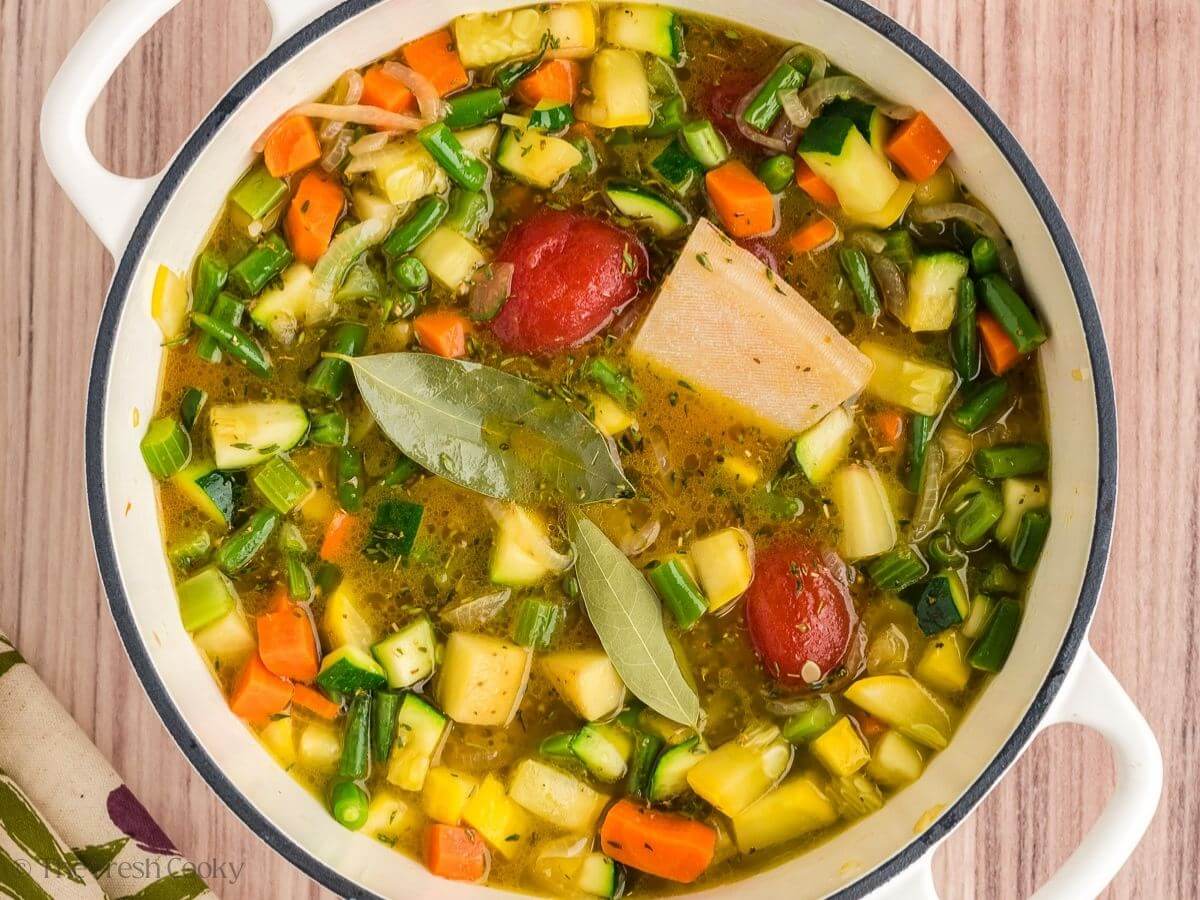
Step 4 – Add Beans & Cook Pasta Separately
After 2 ½ hours, stir the soup, stir in drained cooked cannellini beans (or other) and cook for another 30 minutes. This is a long simmer time, it’s okay to check occasionally and stir the soup if needed.
Note: If needed, you can remove from heat at any time and continue cooking at a later time.
Cook until the mixture is dense and thick, this is not a watery or super brothy soup. If the soup is thickening too much before it has finished cooking, add a bit more beef broth.
About 20 minutes before serving, cook the pasta separately, according to package directions, al dente. Once cooked, drain and return to pan.
If adding kale, spinach or chard add about 10-15 minutes before serving.

Step 5 – Serve & Enjoy
When serving, remove the cheese rind, stir in grated parmesan cheese and balsamic vinegar (or lemon juice), taste and adjust with additional salt if needed.
Place a portion of pasta into each bowl, ladle the soup over the pasta, and garnish with extra parmesan and chopped parsley or basil, if desired. This will avoid the pasta soaking up too much broth and becoming swollen.
Serve with a loaf of crusty bread or make this easy Focaccia bread.

Homemade Minestrone Soup Recipe FAQs
Traditional minestrone soup typically doesn’t contain meat, though it often uses meat-based broths (like the beef broth in this Romagna-style version) for flavor. Historically, it was a peasant dish that made the most of available vegetables. Some regional variations might include pancetta or prosciutto for flavor, but the focus is always on the vegetables.
Minestrone naturally thickens from several ingredients: the starch from potatoes, the breakdown of vegetables during the long cooking process, and the natural starch from beans. No additional thickening agent is needed!
Bland minestrone usually comes from insufficient seasoning or using a lot quality broth. Make sure to add salt gradually and add more at the end of needed. It is also super important to add an acid like balsamic vinegar or lemon juice! Additionally, make sure to use a high quality broth for the most flavor. If it’s still bland after these tips, stir in 1-2 teaspoons (one at a time) of organic beef Better-than-Bouillion.
Simply add more broth until you reach your desired consistency! Then adjust your seasonings. Remember that the soup will continue to thicken as it cooks, so you may need to adjust throughout the cooking process. Make sure to add broth in small amounts to maintain the concentrated flavors.
Cool completely and store your soup in an airtight container for up to one week in the fridge.
Minestrone stores and reheats well. Here’s how to store and freeze it for later use:
To freeze, make sure your soup is cooled completely, and if possible do not add pasta until reheating. Freeze in individual serving containers like Souper Cubes for up to 3 months.
Reheat minestrone by thawing overnight in the fridge and reheating in appropriate-sized saucepan over low heat. If needed, add a bit of beef broth or water, adjusting seasonings to compensate. Stir in cooked pasta or place a small amount into a soup bowl then ladle minestrone over the top.

Variations and Substitutions
- Make it dairy-free (vegan): Don’t garnish with Parmesan, and use vegetable broth instead of beef broth.
- Gluten-free: Substitute your favorite sturdy short gluten-free noodle. I have used Trader Joe’s gluten-free penne with good results.
- Parmesan note: Most Parmesans are not technically vegetarian (they contain animal rennet), but Whole Foods 365 and BelGioioso brands offer vegetarian Parmesan cheese.
- Vegetables: Minestrone was a soup that was meant to use vegetables that are in season, so swap veggies in and out as desired; try adding chopped sweet potatoes, Butternut squash, peas, turnips and rhutabegas.
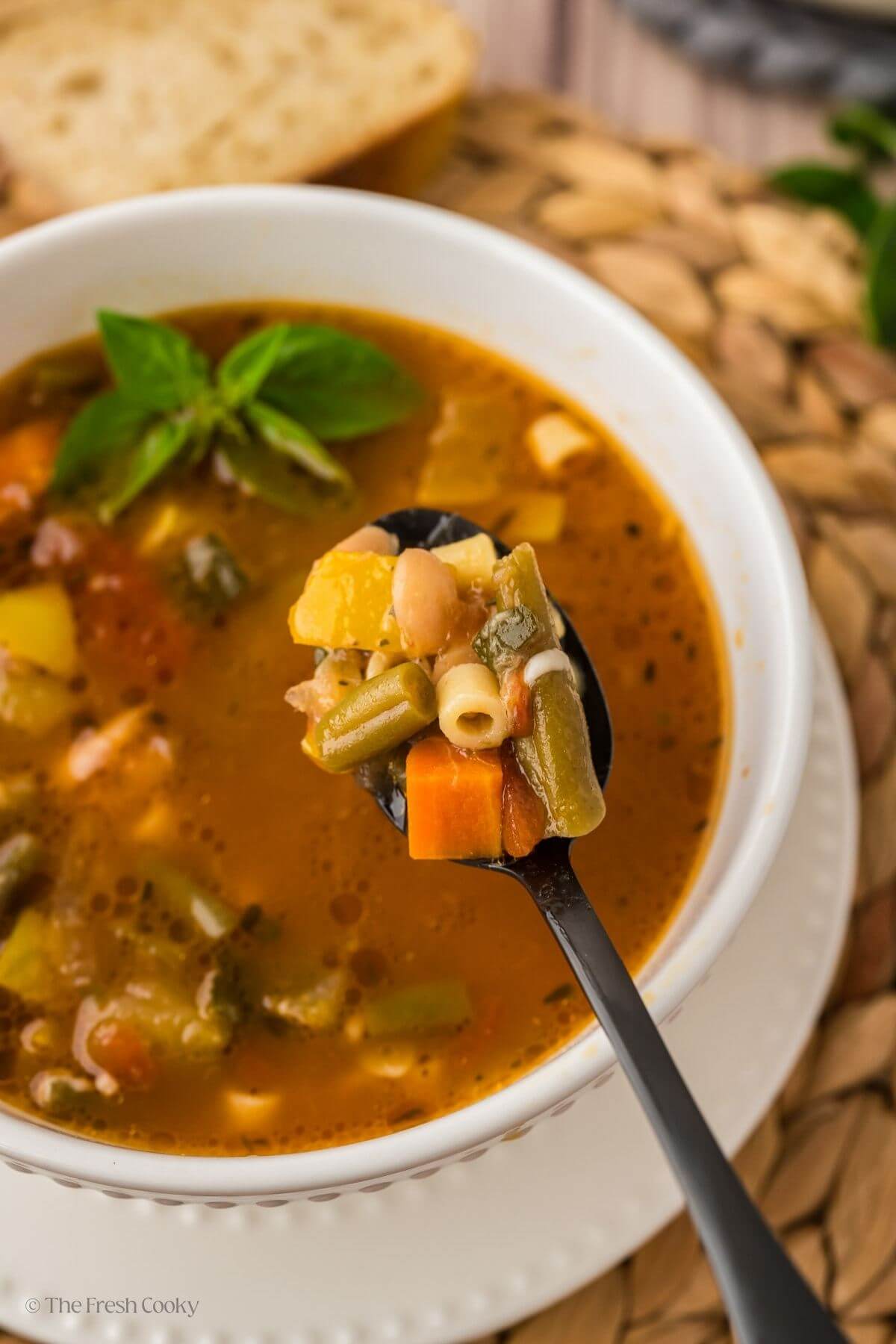
Success Tips for Italian Minestrone Soup
- Vegetable Order Matters: Adding vegetables in sequence allows each to develop its flavor properly and start the cooking process before being simmered in the soup.
- Slow and Steady: The long cooking time (about 3 hours) is crucial for developing all the flavor.
- Pasta Separation: Always cook pasta separately and add to individual bowls to prevent it from becoming mushy and soaking up too much broth.
- Save Those Rinds: Keep Parmesan rinds in your freezer as you go through blocks of it– they’re soup and sauce gold!
- Season at the End: Wait until the end to adjust salt, as the soup reduces and flavors concentrate, so you don’t want it to be too salty! You can always add more salt, it’s darn difficult to pull salt out!
What to serve with Minestrone Soup

More from The Fresh Cooky
Like this recipe?
Don’t forget to give it a ⭐️⭐️⭐️⭐️⭐️ star rating and leave a comment below the recipe!
Equipment
Ingredients
- ½ cup extra virgin olive oil
- 3 tablespoons butter
- 1 medium-large onion cut in half and sliced very thin
- 1 cup carrots diced, about 3 medium carrots
- 1 cup celery diced, about 3-5 stalks
- 2 cups Yukon gold potatoes or Russet potatoes, about 2 small russets or 3-5 small Yukons, see note 1
- ¼ pound green beans fresh, ends trimmed and diced
- 1-2 small-medium zucchini washed and chopped
- 1 small-medium summer squash washed and chopped
- 3 cloves garlic minced
- 6-8 cups beef broth 2 quarts, see note 2
- 1 14 ounce can Italian plum tomatoes see note 3, whole, peeled imported, with juice
- 2 bay leaves
- 1 teaspoon oregano
- 1 teaspoon thyme
- 1-2 parmesan rinds optional, see note 4
- 1 15 ounce can cannellini beans drained and rinsed, see note 5
- 1 teaspoon kosher salt to start, taste at the end and add more salt as needed
- ⅓ cup Parmigiano-Reggiano cheese fresh grated
- 2 teaspoons balsamic vinegar or fresh lemon juice see note 6
- 1 cup ditalini or other short pasta, such as orecchiette, or other small shell pasta, see note 7
- 2-3 cups chopped kale, baby spinach, savoy or regular cabbage, or Swiss chard optional, see note 8
- grated parmesan cheese and basil or parsley for garnish, if desired
Instructions
- Add olive oil and butter over medium-low heat in a 6 quart or larger Dutch oven or soup pot until butter is melted and oil is shimmering. Add onions and cook uncovered until it wilts and becomes a golden pale color, no darker. Give it a stir every few minutes, this takes about 4-6 minutes so it’s go and prep your carrots.
- After onions are soft and golden, stir in the carrots and cook for 2-3 minutes. Then add celery and cook for another 2-3 minutes. Continue adding the vegetables in this order: potatoes, green beans, zucchini, and summer squash, stirring each time and cooking for 2-3 minutes between additions.While one vegetable is cooking, you can quickly prep the next one. Make sure to stay near the stove and stir the pot occasionally.
- Push the vegetables to the side of the pot and add the garlic to the empty side. Saute for 1 minute, stirring, until fragrant. Then stir the garlic into the vegetables.
- Give everything a good stir and cook for a couple more minutes, then add the shredded cabbage (if using) and continue cooking for 5-6 additional minutes.
- Add broth, parmesan rind (if using), and canned tomatoes with their juice.
- Add salt (just a bit, you will adjust and taste at the end), oregano, thyme, bay leaves and stir into the soup. Bring to a boil, cover and reduce to a gentle simmer on low heat for 2 ½ hours.
- After 2 ½ hours, stir the soup, stir in drained cooked cannellini beans (or other) and cook for another 30 minutes. This is a long simmer time, it’s okay to check occasionally and stir the soup if needed.Note: If needed, you can remove from heat at any time and continue cooking at a later time.
- Cook until the mixture is dense and thick, this is not a watery or super brothy soup. If the soup is thickening too much before it has finished cooking, add a bit more beef broth.
- About 20 minutes before serving cook pasta separately, according to package directions, al dente. Once cooked, drain and return to pan (see note 9).
- If adding kale, spinach or chard add about 10-15 minutes before serving.
- When ready to serve, remove the cheese rind, stir in the grated parmesan cheese and balsamic vinegar (or lemon juice) then taste and add additional salt if needed.
- Place a portion of pasta into each bowl, ladle the soup over the pasta, and garnish with extra parmesan and chopped parsley or basil, if desired.
- Serve with a loaf of crusty bread or make this easy Focaccia.
Notes
- If using Yukon Gold or similar potato with thin skins, you do not need to peel them, if using Russet potatoes, they are best peeled first.
- Do not use canned condensed beef broth, or if you do watch your salt and only use 2 cups, adding 4 cups water. Many American minestrone recipes are made with vegetable broth, but I love the Romagna way, which is made with beef broth. You can certainly use vegetable broth to make it vegetarian. Double-check your Parmesan cheese as many of them are made with rennet which is not vegetarian.
- I used San Marzano tomatoes, as they cook they will fall apart in the soup
- Save your parmesan rinds by freezing them, then toss them into your favorite soups! Some deli’s and specialty stores and cheese counters also carry parmesan rinds.
- Great Northern, white, or regular kidney beans may be substituted. Or omitted.
- Adding acid to your soup rounds out and balances the flavors by leaps and bounds! Give it a try!
- If you plan on making this soup ahead of time (or plan on freezing it), keep the pasta out, cooking it separately, cooling completely and adding to each serving bowl just before serving. This way it won’t swell up soaking up all of the liquid.
- Minestrone was a soup that was meant to use vegetables that are in season, so swap veggies in and out as desired; try adding chopped sweet potatoes, Butternut squash, peas, turnips and rhutabegas.
- For best results with your small pasta noodles, cook the pasta separately, according to package directions, al dente. Add what is needed directly to soup bowls, then store leftovers this way.
- Cool pasta completely, place in freeze baggie and toss with 1 teaspoon olive oil. Store in fridge 3-5 days.
- To freeze, cool pasta completely, toss with 1 teaspoon olive oil and place in airtight container or freezer baggie and store 2- 3 months in freezer. To thaw, place in fridge overnight and use in your favorite recipes.




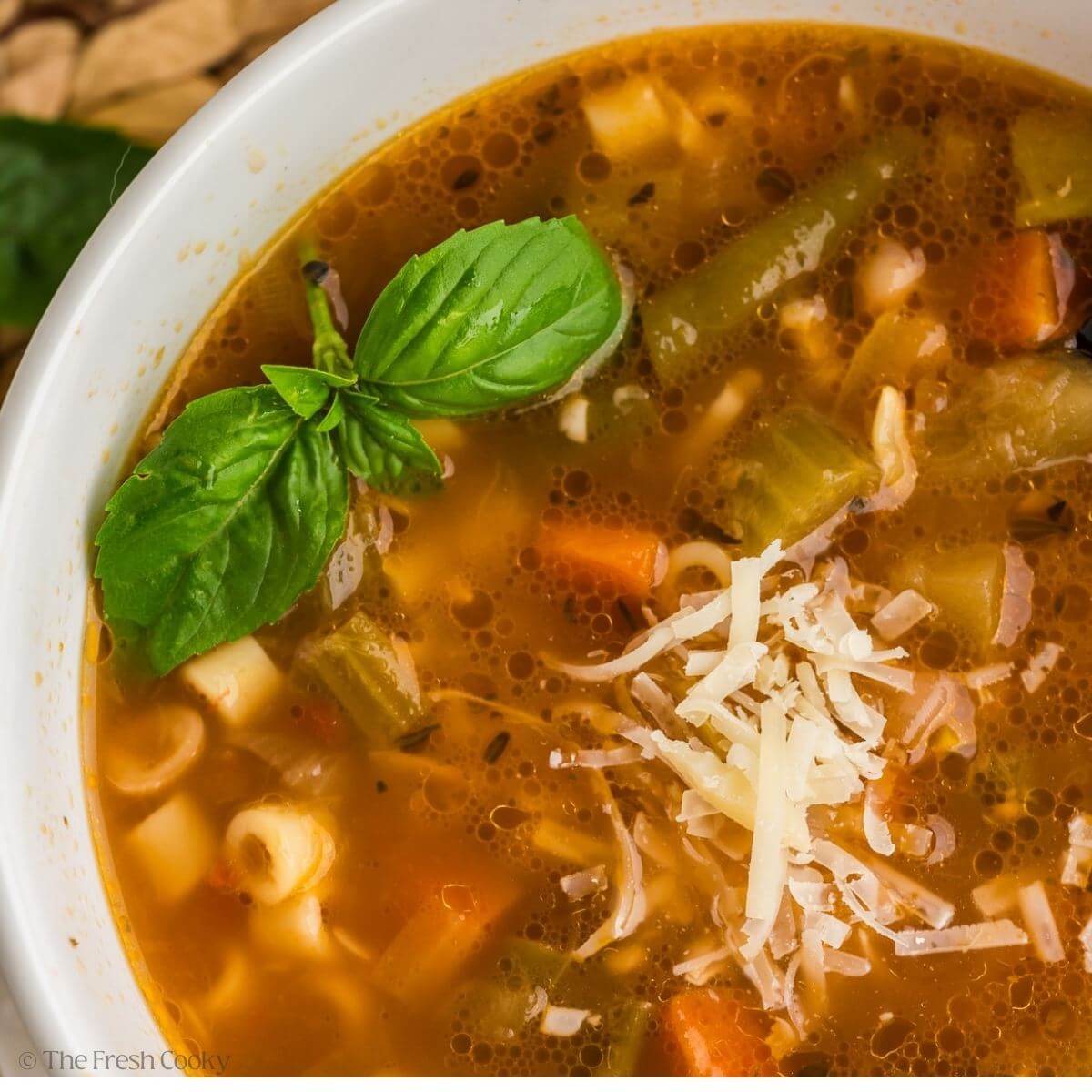



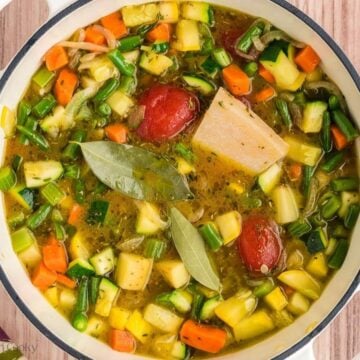





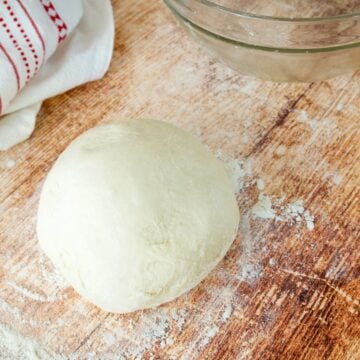



Tasia
I needed something warm and comforting this past weekend and this minestrone soup fit the bill perfectly! {also was a perfect way to use up one of my many parmesan rinds} Thank you for another winner Kathleen!
So glad you loved it Tasia!! It’s one of those “bowl full of comfort”meals for us!